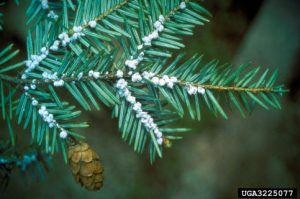
Hemlock Woolly Adelgid. “Their name comes from waxy white filaments they make to protect themselves from drying out. In a heavy infestation, hemlock trees can look gray from all the “wool” on twigs and branches. They can’t fly, but are spread by wind and also hitch rides on the feet of birds, which can carry hemlock wooly adelgids for long distances. These “hemlock vampires” were first discovered in 1951 in Virginia, and by 2005 had spread to fifteen other states.
Source: Paul Hetzler, Cornell Cooperative Extension
Photo source: Connecticut Agricultural Experiment Station, Bugwood.org
——-
UPDATE Nov 16, 2023: Councillor Morse was asked to include Sandy Lake and Sackville Lake Parks in the mention of Hemlock in HRM; she agreed, the motion passed unanimously.
——-
Presence of Hemlock Wooly Adelgid, aka the “Hemlock Vampires” in NS was first realized in the summer of 2017 when it was found to be in the southwestern counties Yarmouth, Digby, Shelburne Counties, and shortly thereafter in Queens and Annapolis Cos; it was found in Lunenburg Co. in 2020 (Invasive Species Council Info) HWA was spreading eastward… In August of 2023, HWA was found on a property in Bedford (Halifax Co.) – view post.
In May of this year, NS Environment and Climate Change advertised a position for a “HWA-OGF Coordinator”.
Now HRM Councillor Kathryn Morse is urging HRM (Halifax Regional Municipality) to develop a plan to address the issue locally.
Date of Council Meeting: November 14, 2023
Subject: Staff report on plan to protect Eastern Hemlock in HRM
Motion for Council to Consider:
That Halifax Regional Council direct the Chief Administrative Officer (CAO) to provide a staff report on a Management Plan for Hemlock Woolly Adelgid in HRM. Woolly Adelgid is an emerging insect pest that can be fatal to hemlock. The Management Plan should include best practices for treatment, with a special focus on older hemlocks in HRM, and include funding sources to develop and implement the plan.
View full request by Councillor Kathryn Morse. View November 14, 2023 Halifax Regional Council, Agenda
Fortunately, though the initiatives of Donna Crossland while she was a Forest Ecologist at Keji, and subsequently in collaboration with concerned citizens/NGOs. some practical testing of targeted pesticide treatments on individual trees and even of a whole stand of trees in NS was initiated earlier on and has shown it can be effective as a stop-gap measure for limited areas. Presumably a plan to address HWA in HRM would entail some combination of measures to slow its spread (e.g., by more vigilance, early removal of infected trees, restrictions on firewood etc.) and application of pesticides to a limited areas and numbers of trees.
Thx Kathyrn Morse, Thx Donna Crossland, & Thx to many volunteers for your efforts to save some vestiges of these wonderful trees and forests while we must wait for more comprehensive and ecologically sound controls.

There are some magnificent stands of Hemlock in HRM
Photo on a drumlin by Sandy Lake (Bedford, NS), Jan 19, 2018.
For more about HWA in Nova Scotia
View HWA in Nova Scotia and its subpages (on this website)
